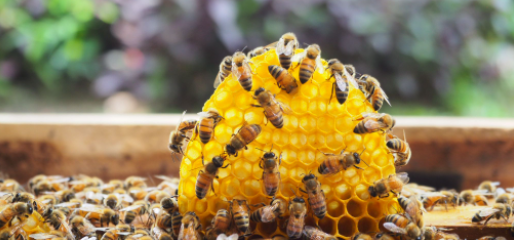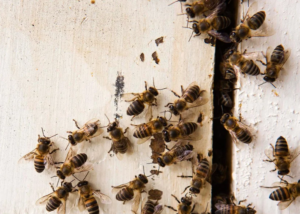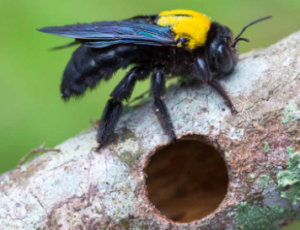- +1 (708) 232-7703
- info@preyonpestcontrol.com
- Serving Chicagoland
Preyon Pest Control offers two free followups for all of our emergency extermination services. You can rest assured that we will successfully “prey on the pests” that are invading your home! Call Preyon Exterminators today at (708) 232-7703.
Don’t wait until your home or business is over-run with bees, call Preyon today!

Bees are an important part of our ecosystem, as we all know. Their pollination activities ensure that flowers blossom and food is available on our tables. Plus, the honey they produce is rather tasty. However, they may be much more than a nuisance when they infest your home or property. They can be hazardous to your family and damaging to your property.
If you suspect a bee infestation, ask yourself these three questions before contacting a San Diego bee removal professional.
An increase in bee activity is a telling sign that you may have a bee infestation on your hands. You might notice that there are more bees flying around your house than usual. You could find bees inside your home when you don’t expect to see them. You might even start to hear bees buzzing about your house.
In any case, the presence of more bees indicates the presence of a hive nearby. Following the bees’ journey routes can often help you find the hive. If you decide to do so, be cautious and take precautions to avoid disrupting the hive.
If you happen to come across a hive on your property, check to see if it’s still active (from a safe distance, of course). Bees coming in and out of a busy beehive as they make their critical foraging trips to local flowers will be visible. Even if you assume that a hive’s inhabitants have abandoned it, avoid disturbing it. Surprising the bees will almost certainly not go well!
The formation of strange dark patches on your walls or ceilings is another indicator that you may have a bee infestation. Honey bees create a nest inside your walls’ structure and fill the cells with honey. Some honey will inevitably leak out of the honeycomb and onto your walls. Wood, drywall, and other building materials will be destroyed by the honey. It can also attract other pests to the region, such as rodents and insects, causing even more damage.
Unless bees pose a threat to humans or your home, it’s best to leave them alone. These three questions should hopefully help you figure out if you have a bee problem.

When dealing with stinging insects, avoid provoking them. Most bees only sting when their hive or queen is in danger. Keeping your distance helps avoid an angry hive. A swarm of bees surrounds the queen on a limb, bush, or post (a doorpost, fencepost, etc.). Avoiding this area should reduce stings.
If the hive or swarm is outside, keep pets, children, and anybody allergic to insect stings indoors. If you have a beehive in your home, try to isolate it.
If the hive is within your home, find out how the bees got in. However, blocking access to the hive may result in bees fleeing into other sections of your home.
It’s tempting to spray the hive or trap the bees. Consider what could go wrong first. The EPA has banned numerous commonly sold insecticides from use near bees, making bee eradication difficult. This makes using such products on bees illegal. With traps, you end up with a container full of enraged insects. Also, if your trap doesn’t catch all the bees, the rest of the hive will remain a problem.
When it comes to honey bees, depending on where the hive or swarm is located, a local beekeeper may be able to take them for free. Check with the American Beekeeping Federation or Apiary Inspectors of America to see whether local beekeepers exist. Other bee species or large indoor colonies may necessitate a pest management professional.
Do you have bees in your walls or other areas of your home like your attic? Clean up after them. Honey and other remnants from bees in walls or cavities may attract animals and insects. To avoid a larger issue, remove any residual honeycomb, repair damaged walls, and seal any entry holes utilized by bees.
This will reduce the chance of being stung and ensure that any bees visiting your home won’t stay long. If you have questions about bee removal, consult one of our beehive experts.
The objective of beehives is to nurture new bees, generate honey, and serve as a communal basecamp. In natural environments, the hive’s internal organization is rather consistent. If you come across a swarm of bees near your property, you may be wondering how to get rid of a beehive. However, before taking action against these buzzing insects, it’s important to understand that bees are beneficial pollinators. Indeed, these insects, notably honey bees, are responsible for a huge portion of the fruits and vegetables you consume. The US Environmental Protection Agency (EPA) and other organizations seeking to reverse a global fall in honey bee populations strongly oppose outright bee slaughter.
Around the world, there are 20,000 different bee species, with 4,000 of them in the United States alone. There were around 25% fewer species found between 2006 and 2015. Thousands of bee species have already fallen extinct in the best-case scenario. In the end, a loss in bee variety caused by increasing rarity or irreversible extinction will have an impact on wild plant and crop pollination, as well as wider ecological and economic implications.
Identifying and learning about common backyard bees may not seem vital, but it is. Sadly, many of these native pollinators are undergoing substantial population losses due to loss of foraging and nesting habitats, pesticide exposure, and numerous illnesses and parasites. Besides being more efficient pollinators than European honey bees, wild bees have evolved alongside our local vegetation. Many bee species are specialized pollinators, built to pollinate certain plants. Our native bees are an integral component of the equation for habitat stability.
Identifying bees is the first step toward respecting their job. The common bumblebee and honeybee are easily identified, but there are numerous other bee species worth learning about.

Approximately 1/3 inch long genuine bees. There are 43 species in North America, from coast to coast. Every year they cover Heliopsis flowers. It, along with oregano in bloom, is their favorite garden plant.
The head, thorax, and abdomen are entirely metallic green. Pollen wads on female hind legs These bees’ colors make them immediately identifiable. Females may nest in little holes in the ground.
These bees collect leaf fluff to line their nests. The Southwest has 20 native species. The non-native wool carder bee prefers the east. This half-inch long bee has a yellow or white pattern on its top abdomen. Females pollinate on their hairy abdomens, not legs. Males defend their territory from competing males in front garden nepeta and foxgloves in early summer. Fly nids on hollow stems and wood. The females pluck the hair from the leaves and bring it back to their nests! A garden bee is the imported European honey bee. They are not native to this continent but are common in gardens. Unlike the other bees, the bee has only one species. It is used to make honey and pollinate plants worldwide.
 Green Metallic Sweat Bee
Green Metallic Sweat Bee These bees are like flying gems! One species is significantly more numerous than the others, with only four species on the entire continent (A. Pura). The quarter-inch-long bees are a striking metallic or tawny green. They frequently dine on the blossoms of oregano, basil, and thyme. They’re also common on daisy-like flowers including asters, black-eyed Susans, coreopsis, and cosmos.
Solitary nest in hollow stem or tunnel in rotting wood by this small bee. They frequently nest in wood nesting blocks. A cuckoo wasp, a near-identical bug, is often confused with this bee. The cuckoo wasp is more turquoise in hue. Strangely, the cuckoo wasp parasitizes many of our native bees and wasps, consuming their larvae. Tricky!
Bumblebees rock! You may pet them as they pollinate! Their chubby, fluffy bodies beg you to stop and stare. They’re charming, lovable, and bumbling! Bumblebees are abundant across the continent, with 50 species. Bumblebees are hairy and half to an inch long, with patterns of black, white, yellow, orange, and even rusty brown. Each species has its own color pattern, making it difficult to distinguish between them. Pollen balls are carried by female bumble bees. They appreciate garden with coneflowers, blueberries, foxgloves, and salvias. They frequent milkweeds, Agastache and phlox as well.
Bumble bees, unlike most other bees on this list, nest in groups. Mated queen bumbles hibernate amid deaf rubbish. Their nests are commonly in abandoned rodent burrows, empty bird houses, or other cavities in the earth. You can also buy a bumble bee nest box to attract them, but remember to clean it out every winter. The nests are made up of clusters of wax balls, each carrying an egg. If you ever get the chance to witness one, do so. Most bumble bee nests contain only a few dozen individuals, compared to a honey bee colony’s 50,000.
You’d enjoy watching leafcutter bees work. The females are quite efficient, utilizing their mandibles to quickly extract leaf fragments for their nests. These leaf pieces are used to stack small cups. Each cup has one egg and pollen for the larval bee. Many garden’s epimediums and heucheras are their favorite leaves. Almost any small tunnel, from hollow plant stems to masonary holes in the side of your house, will do. This is where a female usually makes her brood chamber in our porch swing canopy. The nest is then mud-sealed.
There are roughly 140 species of these bees in North America. The upward pointed, flattened, striped abdomen of this bee is unusual. Females carry pollen on their abdomens, not their hind legs. These bees frequent Rudbeckia, mountain mint (Pycnanthemum), and asters in yards.
Long-horned bees are occasionally seen in gardens, usually on sunflowers. Males of this species have lengthy antennae. On the continent, there are roughly 200 long-horned bee species. Their abdomens feature light hair bands and their legs and thorax are hairy. On the hind legs of females. These sunflower experts are often seen night and day on the blossoms. Long-horned bees construct tunnels in the ground to nest, with multiple females using the same entrance.
Perspiration bees are so named because they love to land on hardworking humans and drink their salty sweat. Their crawling on you tickles a little, but they’re harmless. On the continent, Halictus sweat bees number around ten species. A quarter-inch to a half-inch long bee. Their modest size and black and creamy yellow patterned abdomens help me recognize them. Pollen clings to the hind legs of females.
These bees love black-eyed Susans, sunflowers, Shasta daisies, and other summer-blooming asters. Female sweat bees in this group make solitary nests in earth tunnels, while some species are sociable. The sweat bees are a genus of bees in the genus Lasioglossum. Smaller (usually less than half an inch), North America has 400 species.
At Preyon Pest, we believe in providing affordable pro pest management for bees that is unmatched in the South Suburbs of Chicago. From proactive preventative solutions to on the spot 24 hour emergency solutions, we have you covered. Call today for best bee or beehive removal!
Calumet City, Chicago Heights, Country Club Hills, Crete, East Hazel Crest, Flossmoor, Glenwood, Harvey, Hazel Crest, Homewood, Flossmoor, Lansing, Manteno, Markham, Matteson, Midlothian, Mokena, Monee, Oak Forest, Olympia Fields, Park Forest, Phoenix, Richton Park, Robbins, Sauk Village, South Holland, Steger, Thornton, Tinley Park, University Park, Calumet Park, Dolton and Riverdale.
There is no doubt that bees are beneficial to the garden. However, having a hive in your garden puts you and your family at risk of bee stings. Here are some of the most effective methods for getting rid of bees.
An anti-bee spray that targets their neurological system. This results in paralysis and death. These contain strong chemicals that harm insects and can injure humans and pets.
PT Wasp Freeze II is a contact pesticide. Start spraying 15 feet or less away from the hive.
Showering instead of streaming, it covers more ground. Once on the bee, the chemicals do their thing. They die within minutes of being paralyzed.
It’s better to do this at night when the bees are most active. So you only need to spray one spot. To use bee spray, you must be within the colony’s territory. They may attack you if they feel threatened by your presence. This is a bee spray for the yard or garden only.
Prevent inadvertent aerosol inhalation with proper ventilation. Nonetheless, a mask is advised. Keep away from children and pets.
You can use insecticidal powder to kill all the bees in a bee colony. Like bee sprays, this uses paralyzing and lethal chemicals. It’s one of the greatest bee killer sprays on the market today. An application duster is available, however the bottle supplied works just as well.
Then just squeeze a few times to deposit the powder. To avoid disturbing the bees, do this at night. It takes a few hours, but it kills the colony.
Delta Dust Insecticide is certified for use in food-handling establishments and is totally water-proof.

To ensure ample airspace, fill a hand or power duster only halfway. Shake lightly before use to create a fine dust coating. Apply to bee entry points.
As with any insecticide, avoid inhalation and skin contact. Wipe away any surplus that spills from crevices onto surfaces accessible to humans or pets.
A insect zapper is the greatest way to get rid of bees in your house without using toxic chemicals. The ultraviolet beams from a bug zapper attract insects.
They get electrocuted when they fly too close to the grid and touch it. The dead insects fall to the base or ground, making cleanup simple.
PestNot Bug Zapper kills insects, including bees. It kills bees with 2000 volts of electricity. Despite the high voltage, it is surprisingly energy efficient.
Its watertight head allows for rainy season use. It appears like a blue lantern that attracts insects within an acre. Just plug it in a socket near where the bees buzz and hang it on a hanger. If the nest is far away, use an extension cord. This works best at night near the hive. Check it often to remove dead bees.
This pantry staple has many applications, but few know it also works as a bee repellent. It is an option for those who do not want to use chemical insecticides.
It also works well if you choose not to kill bees. If the infestation is severe, this natural remedy may not be as effective as others.
Although no clear research has been done on why vinegar can discourage bees, it is said to smell bad, inhibit their respiratory function, and induce asphyxia.
There are many ways to use vinegar to repel bees. One is to drown them. Fill many water cans with vinegar.
Then position them near the hive. A DIY bee repellant can be made by mixing equal parts water and vinegar.
This treatment coats bees, making them unable to fly. When approaching the hive using vinegar spray, wear protective gear.
Bees don’t have ears. They feel sound instead of hearing it through their antennae and legs. These catch up bees’ air vibrations.
A bee nest elimination device that uses their sensitivity to sound (Neatmaster Ultrasonic Pest Repeller). It emits sound in three modes: bionic, electromagnetic, and ultrasonic.
To get rid of honey bees, use the first two methods that are invisible by humans. For strong infestations, the third level is preferable, and it is audible.
Some pets can hear the frequency, so keep an eye out for their reaction. This method may be suitable for people seeking a non-toxic, low-maintenance, and easy-to-use honey bee repellent.
Why use ultrasonic to deter bees? Simply plug it in a socket 20-100cm from the floor and within 1200 square feet of the beehive. If you have an indoor bee infestation, you will need one for each room. If it’s outside, no issue.
We understand if you’re scratching your brain, wondering how to keep bees away from things that attract them. Bees seek nectar from plants. So, how can plants deter pests?
In reality, just a few plants are efficient bee repellents. Cucumbers’ acidic peels repel bees and wasps.
These plants have powerful scents that discourage bees. Few bee repellant plants produce blooms, including red germaniums and red marigolds.
The bees will flock to these blossoms, thinking they have pollen. But they have little pollen and an unpleasant odor for the bees. Pitcher plants are natural bee killers.
These carnivorous plants entrap and consume insects. Find out which plants grow best in your area. Pesticides are toxic in small areas, so this is a wonderful alternative.
Aside from planting bee repellent plants, you may want to remove or relocate bee-attracting plants. Replace flowers with lush foliage to keep bees away.
Citronella has a strong fragrance that repels bees. If you don’t have a green thumb, a citronella candle will do the trick.
Citronella Candles are EASIER. Their availability varies. These are excellent sellers since they repel everything from bees to flies.
Lighting a citronella candle near the hive at night. This is the finest time because the bees are home. Plus, you get a nice smell while sleeping. Alternatively, buy citronella essential oil and use an oil diffuser to let the scent permeate the area.
The advantage is that the oil may be simply changed. A citronella candle is non-toxic and clean. It repels bees, not harms them. This is a wonderful strategy to keep bees away from you while allowing them to fertilize the ground. Then you’ll need something stronger.
Mothballs and bees don’t mix like oil and water. But what keeps bees away from it?
Mothballs are insecticides in a spherical shape. Mothballs sublimate (change from solid to vapor) over time. The particles emit a characteristic fresh-from-storage fragrance.
They can be naphthalene or paradichlorobenzene. Naphthalene not only repels but also kills bees. This chemical is hazardous if eaten or inhaled by people or pets.
If you have local beekeepers harvesting honey, don’t use this as it can contaminate the product and make it unfit for human use. Paradichlorobenzene is a safer alternative.
If used sparingly, it repels but does not kill bees. Kids and pets are not as affected as naphthalene. Original mothballs contain 99.75 percent paradichlorobenzene.
If you have a bee problem, place mothballs in old stockings or cheesecloth. Attach a string to the hives. Soap is a strong odorant, therefore use This enhances deterrence but also raises risk of harmful effects. Keep children and pets away from the area.
Trapping bees is one method. It involves luring them into a box they can readily enter but not quickly escape. There are commercial bee traps, but the ideas behind their effectiveness can be simply recreated with household objects.
There is a tiny entry point in all bee traps. A tasty solution lures them in. The bees are drawn in by a small opening and trapped when they can’t get out.
A DIY bee trap can be made using a 2-liter bottle. Five inches from the aperture, cut it in half. Then invert the top and bottom halves. In the funnel shape.
Use a stapler or heavy-duty tape to join the two. Then fill with a sweet mixture. Artificial nectar is best because it is their natural meal. Cane sugar or maple syrup with water are also alternatives.
If you want to kill the bees, throw some solution inside to drown them. If you want to trap them and release them somewhere else to pollinate, use less honey.
Cinnamon is a versatile spice, but few know it may help get rid of beehives. The stink of this natural bee repellant is unpleasant to bees. If their nest smells of cinnamon, they will flee. You can also sprinkle cinnamon on their hive. Wear protective gear since some bees may attack you if they detect the foul odor.
It will take a few days to see effects. A lot of powder attracts bees.
The powder appears to impede movement, and others say crushed cinnamon can kill bees. The common outcome is hive relocation.

The results may not be quick, but you may get rid of bees without using toxic pesticides. It also kills bees without killing them all.
Cinnamon can also be used in a DIY bee repellent. Some cinnamon oil in a cup of baby shampoo can help kill honeybees.
Don’t miss our future updates! Get Subscribed Today!
Preyon Pest Control © 2023-24. All Rights Reserved.